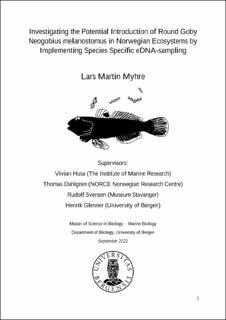| dc.description.abstract | Over the last 150 years, various human activities have altered or weakened ecological barriers. In marine environments the most damaging activity is the ever-increasing, global commercial fleet. By passively transporting species through ballast water or biofouling, the commercial fleet has created pathways across ecological barriers. A species that has dispersed far from its natural range in the Black and Caspian seas through the commercial fleet, is the round goby (Neogobius melanostomus Pallas, 1814). The round goby was spread to the Great Lakes and to the Baltic Sea during the nineties. From there the invasive species has further dispersed both naturally, and through passive transportation. As it has been present Gothenburg, Sweden since 2010, it is expected to arrive in Norwegian ecosystems soon. Although the ecological impact from round gobies is difficult to predict, there are species native to Norway with overlapping niches, and benthic invertebrate taxa that potentially will be negatively impacted by the increased predation pressure. It is therefore of interest to detect the round goby early to limit its dispersal, and to early on map out ecological impacts. This study aimed to investigate a potential introduction of the round goby in the Oslo Fjord. Through fishing campaigns in September 2021 and August 2022, we attempted to verify its presence by catching round gobies. As newly introduced species tend to be of low abundance and patchy distributed, we also implemented eDNA-sampling to further build upon the notion that the method is an asset for detection and monitoring of invasive species. As a positive control both methods were tested in Gothenburg, where populations of round goby are well-established. As expected from other literature we proved that both methods can be implemented to detect round gobies. We found however that eDNA-sampling was more efficient at detecting round gobies than fishing methods, as we only caught the fish at three out of five stations in Gothenburg. More importantly our eDNA results showed weak positive signals in four out of eight stations in the Oslo Fjord. This suggests that the round goby is introduced to the Oslo Fjord, but with significantly lower abundance than in Gothenburg. We did not manage to visually detect the invasive species, even during our second fishing campaign where fishing efforts around two of the positive stations were tremendously increased. We hope that our findings can be applied to other investigative attempts in the Oslo Fjord to focus more fishing efforts at the positive tested stations. More eDNA-sampling should however be collected to help locating the alleged round goby populations. | |

